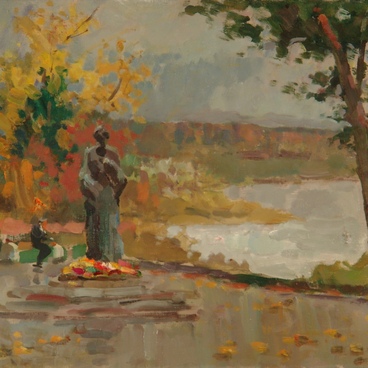The 1960s artist and poet Boris Kocheishvili became the first painter in his family. After graduating from the Moscow State Academic Art College (Homage to 1905), he almost immediately began exhibiting. In 1963, his graphic works were first presented at an exhibition of prints at in the Pushkin State Museum of Fine Arts, and in 1964 he became a member of the Union of Artists of Russia.
He created many graphic and pictorial monochrome works in the 1960s – 1970s. Over the years, the technique and color changed, paintings in a copper palette and reliefs appeared. At the same time, the plots remained equal. He was attracted by the use of fantastic and surrealistic elements in painting. The structure of nature was reduced by the author to geometric volumes. He managed to create depth of space even in works of a small format. Favorite motives of his painting are female images, angels, church architecture, huts, which the artist intentionally stylizes into symbolic objects. His works are in the collections of the State Tretyakov Gallery, the Russian Museum, and private collections.
The artist himself characterizes his painting as more spontaneous, and his poems as more concrete. For five years he lived in a remote village, because he wanted to ‘place himself in the space of the landscape.’ These years were marked by a significant number of poems written and the absence of new painting.
The painting ‘The Chalice’, like many other exhibits, was created by the artist specifically for the exhibition in the Tarusa gallery in 2011, and presented to them as a gift. The coloring of the picture is based on the opposition of two saturated colors: gray-blue for the sky and gold to indicate the horizon of the earth. The artist does not clearly draw the chalice itself with a black outline, depicting it symbolically, and does not convey all the authenticity of its shape and image. At the same time, the author attracts the viewer’s attention, brings dynamics into the painting with a scattering of multi-colored dots, similar to precious stones.
He created many graphic and pictorial monochrome works in the 1960s – 1970s. Over the years, the technique and color changed, paintings in a copper palette and reliefs appeared. At the same time, the plots remained equal. He was attracted by the use of fantastic and surrealistic elements in painting. The structure of nature was reduced by the author to geometric volumes. He managed to create depth of space even in works of a small format. Favorite motives of his painting are female images, angels, church architecture, huts, which the artist intentionally stylizes into symbolic objects. His works are in the collections of the State Tretyakov Gallery, the Russian Museum, and private collections.
The artist himself characterizes his painting as more spontaneous, and his poems as more concrete. For five years he lived in a remote village, because he wanted to ‘place himself in the space of the landscape.’ These years were marked by a significant number of poems written and the absence of new painting.
The painting ‘The Chalice’, like many other exhibits, was created by the artist specifically for the exhibition in the Tarusa gallery in 2011, and presented to them as a gift. The coloring of the picture is based on the opposition of two saturated colors: gray-blue for the sky and gold to indicate the horizon of the earth. The artist does not clearly draw the chalice itself with a black outline, depicting it symbolically, and does not convey all the authenticity of its shape and image. At the same time, the author attracts the viewer’s attention, brings dynamics into the painting with a scattering of multi-colored dots, similar to precious stones.

